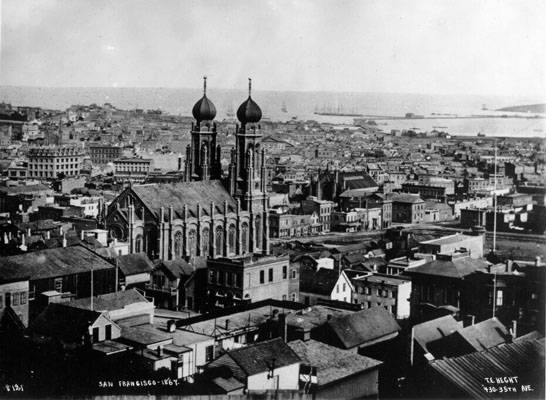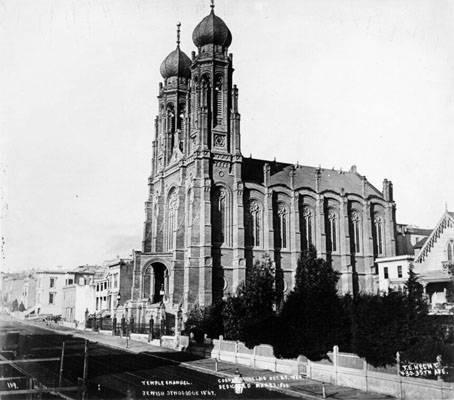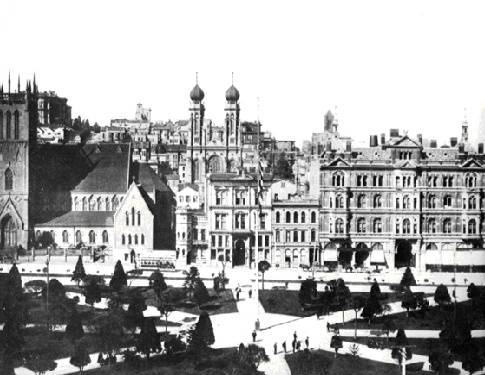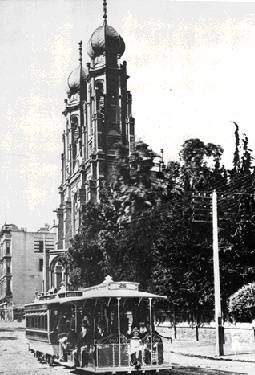Temple Emanu-El of SF: Difference between revisions
(PC) |
m (reordered photos) |
||
| Line 4: | Line 4: | ||
'''Temple Emmanu-el, 1867, [[MISSION BAY|Mission Bay]] and Long Bridge in distance.''' | '''Temple Emmanu-el, 1867, [[MISSION BAY|Mission Bay]] and Long Bridge in distance.''' | ||
''Photo: San Francisco History Center, San Francisco Public Library'' | |||
[[Image:Temple Emanuel 1867 AAB-1709.jpg]] | [[Image:Temple Emanuel 1867 AAB-1709.jpg]] | ||
'''Temple Emmanu-el, 1867.''' | '''Temple Emmanu-el, 1867.''' | ||
''Photo: San Francisco History Center, San Francisco Public Library'' | |||
[[Image:jewishsf$union-square-1891.jpg]] | [[Image:jewishsf$union-square-1891.jpg]] | ||
''' View north across Union Square 1891.''' | ''' View north across Union Square 1891.''' | ||
''Photo: San Francisco History Center, San Francisco Public Library'' | |||
[[Image:jewishsf$old-temple-emmanu-el.jpg]] | |||
'''The old Temple Emmanu-el on Sutter near Powell Street (destroyed in the 1906 earthquake). ''' | |||
''Photo: San Francisco History Center, San Francisco Public Library'' | |||
Temple Emmanu-el was the wealthier of two original Jewish congregations, representing the German-born Jews in early San Francisco. | Temple Emmanu-el was the wealthier of two original Jewish congregations, representing the German-born Jews in early San Francisco. | ||
| Line 20: | Line 32: | ||
The Temple Emmanu-el congregation of 260 mostly German Jews soon moved into a newly built large and elegant synagogue on 450 Sutter St. in 1864. Dr. Julius Eckman, an active pro-Union supporter during the Civil War and ironically a Polish Jew, was the first rabbi to preside over the elite congregation. | The Temple Emmanu-el congregation of 260 mostly German Jews soon moved into a newly built large and elegant synagogue on 450 Sutter St. in 1864. Dr. Julius Eckman, an active pro-Union supporter during the Civil War and ironically a Polish Jew, was the first rabbi to preside over the elite congregation. | ||
[[S Bachman Letters | Prev. Document]] [[Temple Emmanu-el 1990s |Next Document]] | [[S Bachman Letters | Prev. Document]] [[Temple Emmanu-el 1990s |Next Document]] | ||
[[category:Jewish]] [[category:1860s]] [[category:German]] [[category:Polish]] [[category:1880s]] | [[category:Jewish]] [[category:1860s]] [[category:German]] [[category:Polish]] [[category:1880s]] | ||
Revision as of 21:52, 17 January 2009
Unfinished History
Temple Emmanu-el, 1867, Mission Bay and Long Bridge in distance.
Photo: San Francisco History Center, San Francisco Public Library
Temple Emmanu-el, 1867.
Photo: San Francisco History Center, San Francisco Public Library
View north across Union Square 1891.
Photo: San Francisco History Center, San Francisco Public Library
The old Temple Emmanu-el on Sutter near Powell Street (destroyed in the 1906 earthquake).
Photo: San Francisco History Center, San Francisco Public Library
Temple Emmanu-el was the wealthier of two original Jewish congregations, representing the German-born Jews in early San Francisco.
On Rosh Hashana of 1849 the young merchant Lewis Abraham Franklin's storage tent on Jackson Street became the site of the first Jewish service held in San Francisco. However, the first synagogue would not be established for five more years.
A rift between those of German and Polish background marked a breakdown within the small Jewish community. The establishment of two separate synagogues in 1854 - Emmanu-el for the German Jews, and Sherith Israel helped solidify the division that would last well into the 20th century. The German Jews brought to America their European cultural bias against Eastern European Jews as inferior and considered themselves the "aristocrats of the emigres."
The Temple Emmanu-el congregation of 260 mostly German Jews soon moved into a newly built large and elegant synagogue on 450 Sutter St. in 1864. Dr. Julius Eckman, an active pro-Union supporter during the Civil War and ironically a Polish Jew, was the first rabbi to preside over the elite congregation.




